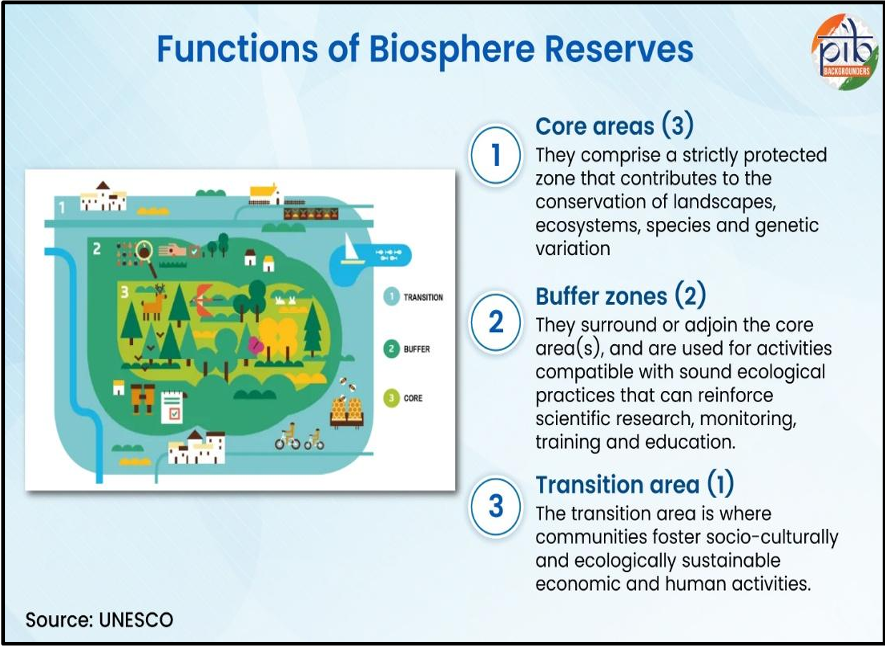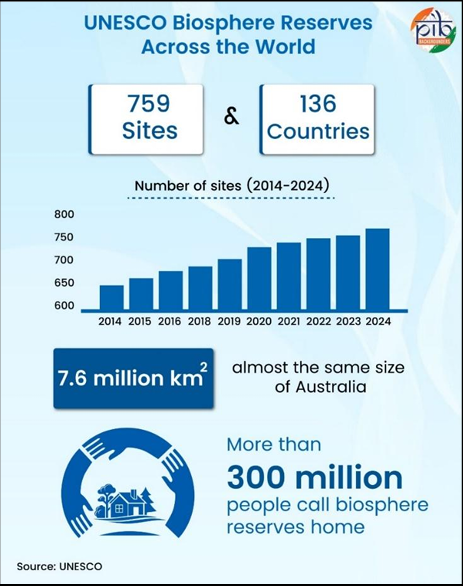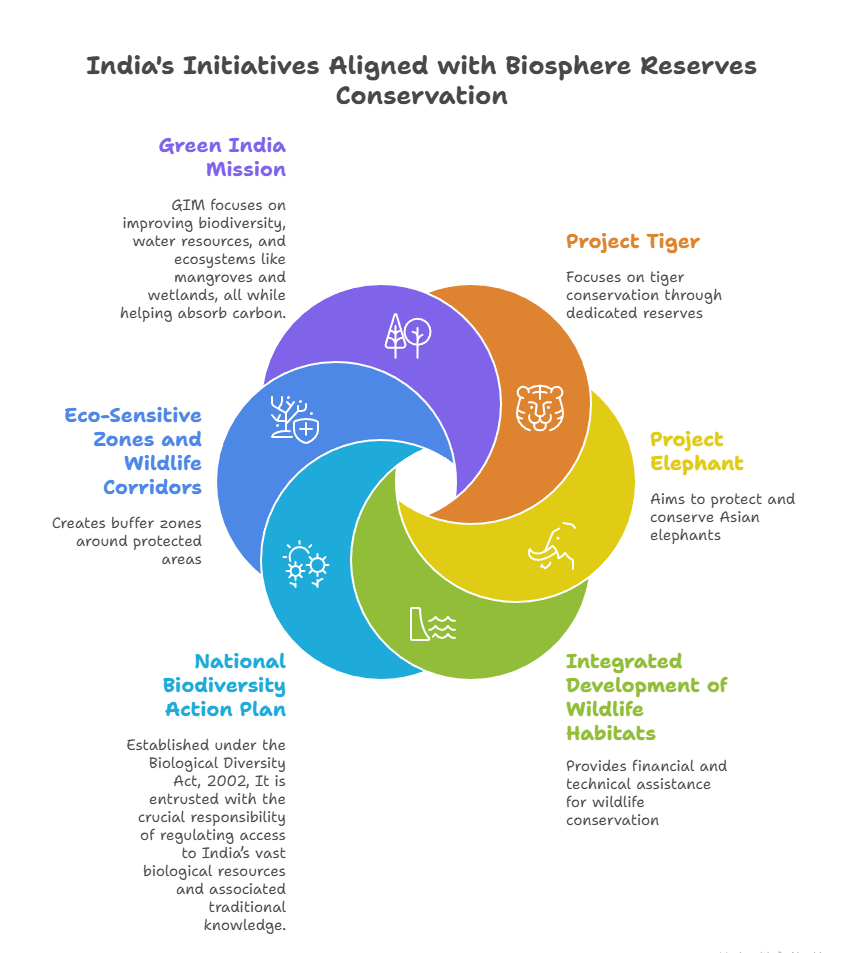Biosphere Reserves in India | 05 Nov 2025
For Prelims: Biosphere Reserves, World Network of Biosphere Reserves, MAB Programme, Cold Desert
For Mains: India’s Biosphere Reserve architecture, Conservation, UNESCO MAB Programme
Why in News?
India celebrated the International Day for Biosphere Reserves, reaffirming its commitment to biodiversity conservation and sustainable development. The day highlights how biosphere reserves serve as spaces where people and nature coexist through scientific research, ecological protection, and community participation.
International Day for Biosphere Reserves
- Observed on 3rd November, this day was established by United Nations Educational, Scientific and Cultural Organization (UNESCO) in 2022 to highlight the role of biosphere reserves in conserving biodiversity and promoting sustainable development.
- It aims to raise awareness, share best practices, and showcase achievements of the World Network of Biosphere Reserves (WNBR).
What are Biosphere Reserves?
- About: Biosphere Reserves (BRs) are special areas designated to conserve biodiversity while supporting sustainable development.
- They serve as “learning places for sustainable development,” helping study and manage interactions between people and nature.
- Key Features: Biosphere reserves include terrestrial, marine and coastal ecosystems. Each site promotes solutions reconciling the conservation of biodiversity with its sustainable use.
- BRs are government-nominated sites that remain under national sovereign control, showcasing how people and nature can coexist sustainably.
- Global Presence: Globally, over 260 million people live in biosphere reserves, covering around 7 million sq. km (an expanse roughly equal to the size of Australia).
- UNESCO Man and Biosphere Programme:The MAB Programme launched in 1971, is an intergovernmental initiative that uses science to improve how people and nature coexist, promoting sustainable development and ecosystem protection.
- Its World Network of Biosphere Reserves serves as a global platform for BRs sites that foster harmony between nature and communities through knowledge sharing, participation, and culturally appropriate development.
- Biosphere Reserves in India: India has 18 Biosphere Reserves covering about 91,425 sq. km, of which 13 are part of UNESCO’s WNBR.
- Spread across mountains, forests, coasts, and islands, they reflect India’s rich biodiversity and community-focused conservation.
How is India promoting Biosphere Reserves?
- Policy Framework: The Biosphere Reserve Division of the Ministry of Environment, Forest and Climate Change implements a Centrally Sponsored Scheme namely Conservation of Natural Resources and Ecosystems (CNRE), under which a dedicated sub-scheme for Biosphere Reserves provides funding support.
- It follows a 60:40 Centre–State model (90:10 for NE and Himalayan states) and prioritises local communities through alternative livelihoods and eco-development, focusing on buffer and transition zones to reduce pressure on core areas.
- Integration with National Initiatives: India’s BRs conserve biodiversity and support communities, complementing initiatives like Project Tiger, Project Elephant, Green India Mission, Integrated Development of Wildlife Habitats (IDWH) Scheme, and National Biodiversity Action Plan (NBAP) for balanced, sustainable development.
What are the Challenges in Managing Biosphere Reserves?
- High Human Pressure on Ecosystems: Heavy dependence on forests for fuel, fodder, and grazing degrades ecosystems, for example, excessive grazing in the Cold Desert BR (Himachal Pradesh) is damaging fragile alpine habitats.
- Expanding agriculture, tourism, and infrastructure fragments ecosystems, as seen in the Nilgiri BR, where development pressures threaten key elephant corridors.
- Poaching & Illegal extraction: Wildlife poaching, timber logging, and overharvesting of forest produce continue to threaten biodiversity as seen in Simlipal BR (Odisha) has reported poaching of tigers and elephants.
- Climate Change Impacts: Climate change is causing sea-level rise, salinity intrusion, and extreme weather, threatening ecosystems, as observed in the Sundarbans BR, which is facing coastal erosion and mangrove loss.
- Weak integration of research into management: Limited scientific monitoring reduces evidence-based planning and baseline data gaps hinder long-term planning of BRs.
- Tourism Pressure: Unregulated tourism affects habitat quality and increases pollution. High tourist footfall in Nanda Devi BR (Uttarakhand) has led to waste generation and trail erosion.
- Boundary Management Issues: Poor demarcation of core, buffer, and transition zones affects enforcement. For example in Gulf of Mannar BR (Tamil Nadu), multiple fishing and industrial activities complicate zoning.
- Community vs Conservation: Local livelihood needs can conflict with conservation rules, leading to resistance against access restrictions.
- For example, in Sundarbans BR, dependence on fishing and honey collection often clashes with habitat protection and core-zone regulations.
What Measures can be Taken for Effective Management of Biosphere Reserves?
- Deepen Community-Led Conservation: Expand Joint Forest Management (JFM) and strengthen Gram Sabha roles under Forest Rights Act, 2006 and Promote sustainable NTFP management through Van Dhan Vikas Kendras.
- Strengthen Sustainable Livelihoods: Scale up eco-development and green jobs under Green India Mission (GIM) in Buffer & Transition Zones of BRs.
- Promote nature-based tourism, agroforestry, and value-chain development to reduce forest dependence.
- Enhance Funding & Institutional Capacity: Increase CNRE allocations and enable multi-year funding. Strengthen State BR Authorities and invest in trained ecological and social science personnel.
- Improve Scientific Monitoring & Data Systems: Mandate long-term ecological research in BRs through partnerships with Indian Council of Agricultural Research, and Zoological Survey of India.
- Scale use of remote sensing and GIS through National Remote Sensing Centre (NRSC) for habitat and wildlife monitoring.
- Better Zonation & Enforcement: Digitally map core–buffer–transition boundaries. Boost anti-poaching and enforcement through tech-enabled patrolling (M-STRiPES style).
- Climate-Resilient Management Strategies: Integrate BR plans with State Action Plans on Climate Change (SAPCC). Restore degraded landscapes and mangroves (especially in coastal BRs like Sundarbans).
Conclusion
India’s observance of the day reaffirms its commitment to biodiversity and sustainable development. Through UNESCO’s MAB partnership and community-driven conservation, India continues to lead globally in balancing nature and livelihoods.
|
Drishti Mains Question: Q. Critically evaluate India’s use of Biosphere Reserves as “living laboratories” to reconcile conservation with development |
Frequently Asked Questions (FAQs)
1. What is the Man and the Biosphere Programme?
The Man and the Biosphere Programme was launched by the United Nations Educational, Scientific and Cultural Organization in 1971 to improve the relationship between people and the environment through conservation and sustainable development.
2. How many Biosphere Reserves are in India?
India has 18 Biosphere Reserves, of which 13 are part of the World Network of Biosphere Reserves.
3. Which ministry administers funding for Biosphere Reserves in India?
Funding is provided by the Ministry of Environment, Forest and Climate Change under the Centrally Sponsored Scheme on Conservation of Natural Resources and Ecosystems.
UPSC Civil Services Examination, Previous Year Question
Prelims
Q. The most important strategy for the conservation of biodiversity together with traditional human life is the establishment of (2014)
(a) biosphere reserves
(b) botanical gardens
(c) national parks
(d) wildlife sanctuaries
Ans: (a)
Q. Out of all the Biosphere Reserves in India, four have been recognized on the World Network by UNESCO. Which one of the following is not one of them? (2008)
(a) Gulf of Mannar
(b) Kanchenjunga
(c) Nanda Devi
(d) Sunderbans
Ans: (b)



.png)

